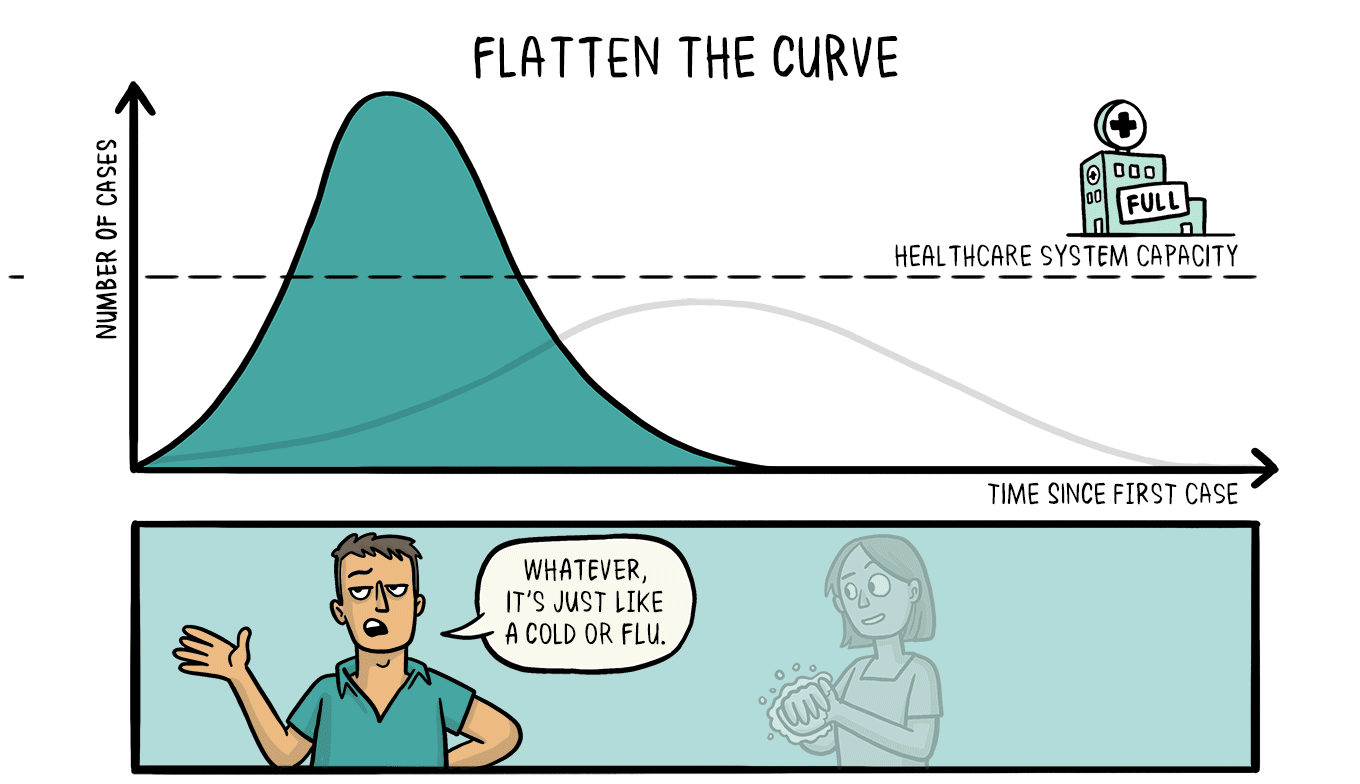Not only does social distancing can help stop or slow the spread of communicable diseases, it also helps “flatten the curve” which takes pressure off the healthcare system.
Social Distancing Can Combat the Spread of Communicable Diseases fact

Social Distancing is Effective at Stopping or Slowing the Spread of Communicable Diseases
Communicable diseases spread from one person to another. Thus, social distancing can combat the spread of communicable diseases like the flu or coronavirus.[1][2][3][4][5][6][7]
The amount and the extent of distancing needed is dependent on the disease, but in general social distancing measures can slow or even stop the spread of communicable diseases.
For example, Deborah L. Birx, M.D. of the U.S. Department of State was citing by NPR as saying that models that looked at the spread of COVID-19 showed that a 14-day quarantine of any household with one or more infected people stopped 100% of transmissions outside of the household.
Why fighting the coronavirus depends on you.What is Social Distancing?
Social distancing is what it sounds like, keeping your distance from other people. That means keeping space between you and other people, and that means staying away from crowds.
For example, with COVID-19 it is generally recommended to stay at least six feet away from other people and to avoid gatherings of more than 5 – 10 people.
At an extreme social distancing can look like self quarantine (staying home and not being around others for a period of time), but at its simplest it is just keeping space between you and other people.
What is a Communicable Disease?
A communicable disease is one that spreads from person-to-person, for example a disease that spreads though blood and bodily fluids or is airborne. Although some communicable diseases can be spread through insect bites or contaminated surfaces, these diseases are ultimately transferred between people.
Why is Social Distancing Effective?
The reason social distancing is effective at combatting the spread of communicable diseases is simple. Communicable diseases spread from person-to-person, and thus keeping distance from other people helps to stop or slow transmissions.
How Much Social Distancing is Needed?
The amount of distancing needed depends on how to diseases is spread, how easily it spreads, reinfection rate, and how long it takes a person to not be contagious anymore.
COVID-19 for example is thought to be spread via droplets and surfaces according to the CDC. It Is also shown to be highly communicable, and there is a risk of reinfection. Further, it seems to spread most easily when people are most symptomatic. However, Coronavirus is not thought to be airborne according to the World Health Organization [PDF].
Based on these facts, we get recommendations like staying six feet away from a person, self quarantining if sick for at least 14 days, and washing your hands (especially if you touch surfaces others might have touched).
What is the Proof Social Distancing Works?
In general, our logic can tell us that social distancing works to combat communicable disease. The disease is transmitted between people, therefore people staying away from each other slows the spread.
With that in mind, there is also data that backs this up. Both historic data and models.
For example, see this article/chart “TALE OF TWO CITIES This chart of the 1918 Spanish flu shows why social distancing works.” This compares two cities during the Spanish flu. In simple terms, the one that implemented social distancing tactics sooner stopped the spread of the Spanish flu sooner. More data on this can be seen in a research article from Princeton published on PNAS called “Public health interventions and epidemic intensity during the 1918 influenza pandemic.”
We also have recent data, like the models noted above cited by NPR.
Flattening the Curve
Slowing the spread of diseases isn’t just about keeping total infections low, it is about stopping everyone from being infected at once and overwhelming the healthcare system.
Overwhelmed healthcare systems can’t properly deliver care to the sick, and they can struggle to deliver the care they normally otherwise would.
Different Levels of Social Distancing Flatten the Curve: Without social distancing diseases can spread quickly and lead to everyone being infected around the same time. This can put real pressure on the healthcare system. Extensive distancing can extend the length the disease is around for, but helps ensure there aren’t too many cases at once. To see a visual of this, and to learn more about flattening the curve, check out this article from WashingtonPost.
Coronavirus outbreak: As cases rise, how will Canada “flatten the curve”?.- It’s Time To Get Serious About Social Distancing. Here’s How. Npr.org.
- Communicable Disease. acphd.org.
- Coronavirus, Social Distancing and Self Quarantine. Hopkinsmedicine.org.
- Coronavirus Disease 2019 (COVID-19) – How It Spreads. Cdc.gov.
- Public health interventions and epidemic intensity during the 1918 influenza pandemic. Pnas.org.
- WHAT IS SOCIAL DISTANCING AND HOW CAN IT SLOW THE SPREAD OF COVID-19? Jhu.edu.
- Report of the WHO-China Join Mission on Coronavirus Disease [PDF]. Page 8. Who.int.
